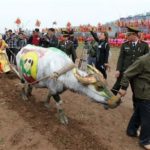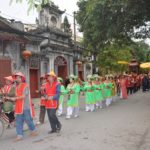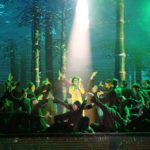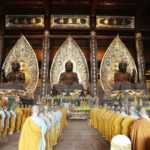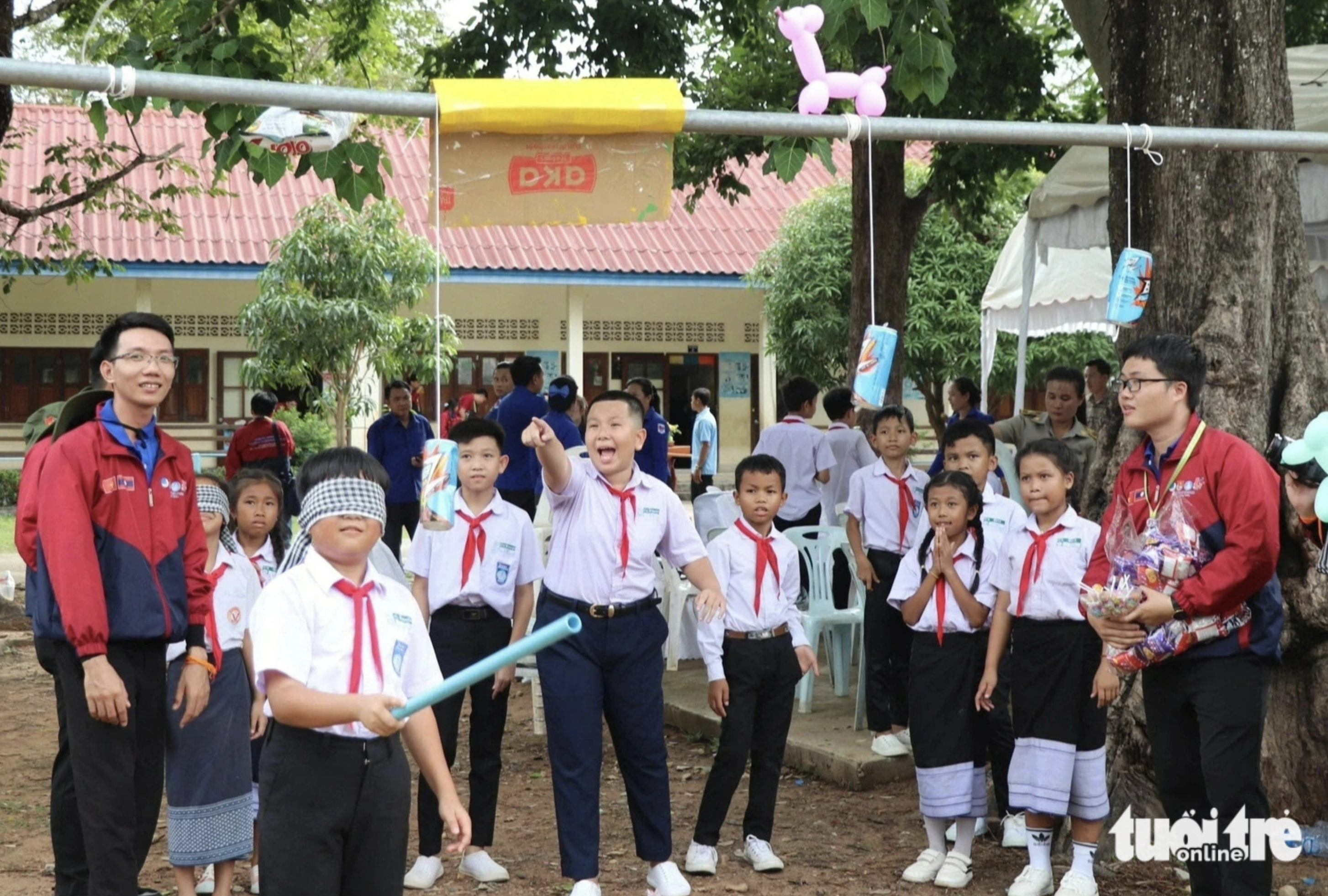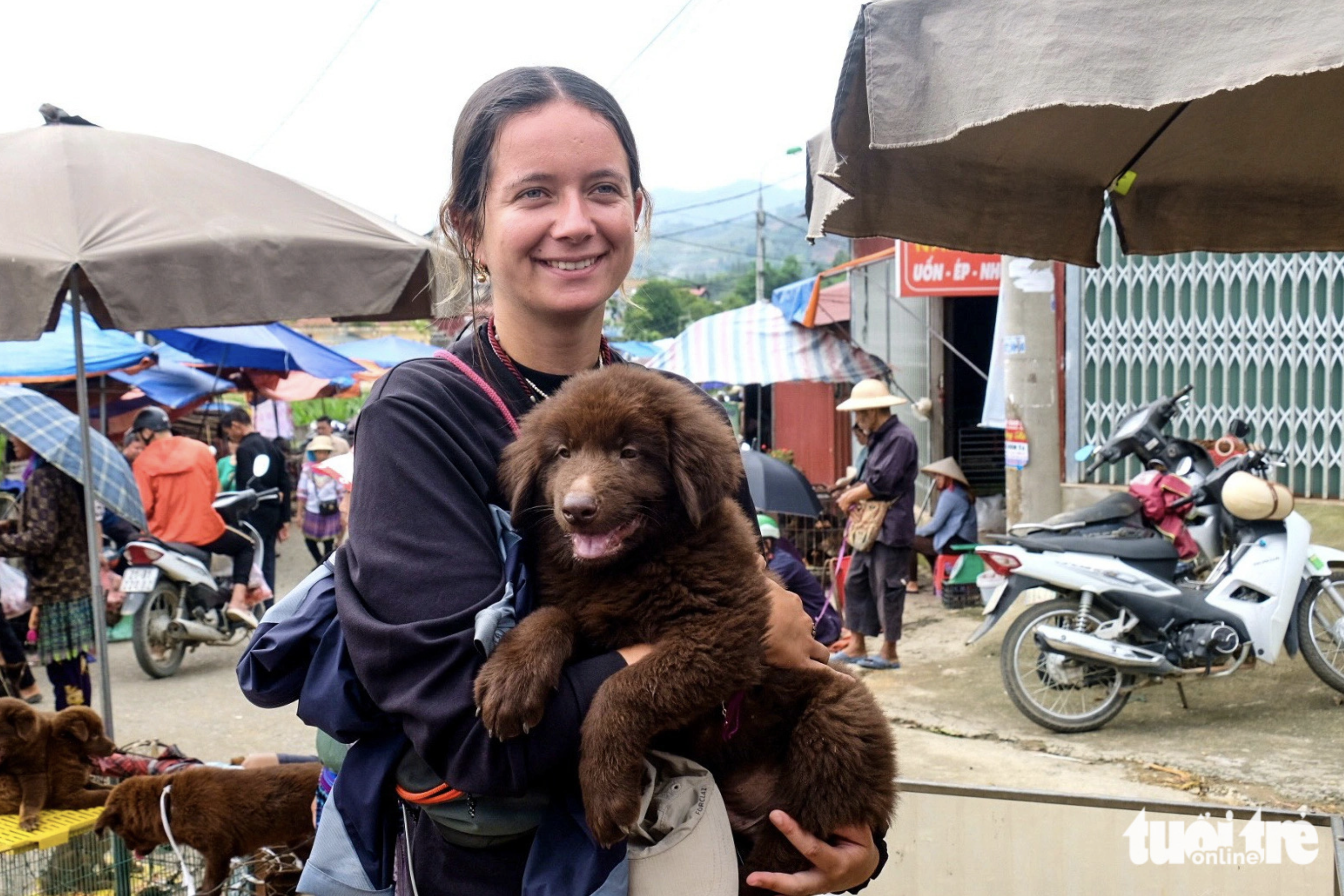The Dong Mo tourist area in Son Tay Town, a suburb of Hanoi, takes on a much livelier atmosphere around mid-April each year. On this special day, the locals transform from barefoot farmers into bustling market-goers and art enthusiasts. From the surrounding areas, ethnic minorities gather to celebrate this vibrant occasion with traditional costumes, lively music, and delicious food. It is an event that truly brings the area to life.
| The joyful atmosphere to celebrate Vietnam’s Ethnic Groups Cultural Day (April 19) at Vietnam Ethnology Cultural and Tourist Villages. Photo: VNA |
The annual Festival to celebrate Vietnam’s Ethnic Groups Cultural Day (April 19) will be held from April 14 to 19 at the Vietnam Ethnology Cultural and Tourist Villages. With the theme “Colors of the Cultures of Vietnamese Ethnic Groups”, the week-long festival promises to bring a vibrant and joyous atmosphere to both locals and international visitors. An array of activities and events will be held in honor of the occasion, giving guests a unique opportunity to explore and experience the rich cultural heritage of the nation. From traditional dance performances to musical concerts, there is something for everyone to enjoy. This annual celebration is a great way to strengthen the bonds between the different ethnic groups of the country and to foster appreciation of their cultural diversity.
The Vibrant Hues of Vietnam’s Ethnic Groups
Vietnam is known for its beautiful natural landscapes, but the country is also home to a wealth of cultural diversity. Vietnam has 54 different ethnic groups, each with its own unique customs, languages, and clothing styles. These diverse cultures are expressed in the bright colors and intricate designs of the traditional costumes of the Vietnamese people.
The costumes of the ethnic groups vary widely, from the bright red and yellow of the Hmong to the more subdued green and brown of the Muong. Some ethnic groups, such as the Dao and the Nung, wear bright and colorful clothes that are elaborately decorated with patterns and embroidery. Others, such as the Hmong, wear simpler clothes in plain colors, often with the addition of a few colorful accents.
Regardless of the style, the costumes of the ethnic groups in Vietnam are a vivid expression of the culture and heritage of the country. From the bright reds and yellows of the Hmong to the more subdued greens and browns of the Muong, the traditional costumes of Vietnam are a beautiful reminder of the country’s rich cultural history.
At 6:30 am, buses full of tourists and guests arrive at the Vietnam Ethnology Cultural and Tourist Village, located approximately 40 km from the center of Hanoi. The tranquil atmosphere is suddenly alive with visitors, and the sound of traditional gongs, panpipes, and other instruments fills the air. A group of ethnic Thai girls, dressed in white, form-fitting traditional attire, perform the mua sap dance between bamboo poles to the delight of the crowd. Nearby, an ethnic Yao man is applauded for his captivating singing.
Impressed by a group of Flower Hmong girls decked out in their vibrant attire, eager to meet boys, my friend and I decided to join the group. Amidst the buzz of excitement among the young girls, an elderly Hmong mother worked diligently at weaving a piece of cloth. Clothing of this ethnic minority, especially that of the women, showcases their hard work, ingenuity, and appreciation for beauty. It’s clear that the Hmong people are among the few in the world who still make most of their own garments.
“It takes 21 stages to craft our dress, from planting the lin tree to weaving the cloth and then hand-embroidering the clothing,” Giang Thi Mua, a 55-year-old Flower H’mong woman from Quan Ba commune in northern Ha Giang province, shared with The Hanoi Times.
| Linen spinning and weaving have been passed down from mother to child in the families of the H’Mong ethnic group in Vietnam. Photo: Thuong hieu & Cong luan |
When she was six, the woman’s mother taught her how to complete each stage of her needlework. She takes advantage of her free time while working on the farm or watching the family’s buffalo graze to practice her craft. It can take up to a month to complete a dress if she works continuously, or up to six months if she works only when she has time. Unfortunately, the elderly H’mong woman, like many others, is suffering from failing eyesight.
Mua stated that red is widely used by the H’Mong people as it is seen as a sign of strength, joy, good luck, and as a form of protection from evil. Moreover, they believe that this color holds special significance.
On an indigo background, the collars and sleeves of women’s dresses are intricately embroidered with intricate patterns. The pleats of the skirts are said to symbolize the mountains of their homeland, with the patterns following ancient H’mong calligraphy. Other patterns are inspired by nature, featuring images of plants, animals, the moon, and the sun, while the fabrics are further decorated with small silver beads or bells.
“A H’mong bride’s dress is crafted by her mother and is often adorned with intricate patterns that symbolize the bride’s family’s health and social standing,” said Mua.
The dress becomes her most cherished possession, and she will don it again when she is laid to rest, so that her mother will be able to identify her in the afterlife.
Time for Delicious Ethnic Specialties! Enjoy the unique flavors of cuisine from around the globe with an array of authentic dishes. From Mexican tacos to Indian curries, there’s something to please every palate. With the perfect blend of spices, these mouthwatering recipes will have you coming back for more. So gather your friends and family and get ready to experience the tastes of the world!
| Visitors to Vietnam Ethnology Cultural and Tourist Villages these days will have chance to try thang co or horse hotpot, a specialty of H’Mong group. Photo: Sapa Review |
Standing next to a boiling pot of thang co (horse hotpot), Lo Huy Gia, a 40-year-old H’Mong man from Ha Giang’s Meo Vac town, introduced himself as the “most famous” thang co vendor at the Meo Vac village fair.
His huge pot of thang co, worth about VND5 million or around US$220, was almost empty by 3pm at the end of the fair. “It’s always gone by the end of the day,” he said.
A popular traditional dish among the H’Mong people, thang co is a staple in every mountain market throughout northern Vietnam. Despite its unpleasant smell and taste, the dish has been modified to fit the palates of both local and foreign tourists. This has allowed for the dish to remain popular amongst both visitors and locals alike.
To make a delicious thang co, Gia said he had to venture to remote minority markets to purchase ponies and mature goats. Rising in the wee hours of the morning, they slaughtered the animals and chopped their meat, bones, and intestines into pieces to make a flavorful stew served in a large hot pot.
To sample the delicacy, diners use their chopsticks to pick up the succulent pieces of meat and intestines, then dip them into a bowl of spicy sauce for an unforgettable flavor.
“It’s certainly an acquired taste, made easier to enjoy when accompanied by copious amounts of corn wine,” Thang Do, a traveler from Ha Nam Province, told The Hanoi Times.
According to the H’mong ethnic people, the dish of thang co is a flavourful combination of salt and spices, such as thao qua (cardamom) and dia dien (pineapple peel), which give it a unique, spicy-sweet aroma. It is traditionally served with men men, a type of bread made from corn flour.
Because the dish is served in a large bowl, ethnic people never eat Thang Co alone. They usually sit around low tables on mats in restaurants and enjoy the meal with a glass of corn wine or other alcoholic beverages. At ethnic minority markets, such as the one in Meo Vac, Thang Co is a favorite among the men, who often gather around a fire and the large hot pot, sipping the dish, conversing, and drinking wine from morning until afternoon.
A Funky and Unforgettable Tourist Attraction
Experience something truly unique and unforgettable with a visit to a funky tourist attraction. Whether you’re looking for something fun and unusual to do on vacation or you’re just searching for a unique experience close to home, these attractions are sure to add some extra interest to your trip. From historic sites to interactive museums, you’ll be sure to find something that will keep you entertained for hours.
From quirky museums to underground art galleries, explore some of the most fascinating tourist attractions around. Discover hidden gems like the International UFO Museum and Research Center in Roswell, New Mexico or the famous Bodies Exhibit in Las Vegas. Get a taste of history with a visit to one of the many historic sites around the world, such as the Eiffel Tower in Paris or the Great Wall of China.
For a truly unforgettable experience, check out interactive tourist attractions like the Mystery Spot in Santa Cruz, California or the AtmosFEAR! Scare Factory in Canada. There’s also the Ripley’s Believe It or Not! Odditoriums across the United States and Canada, offering a wide range of strange and unusual items.
So, if you’re looking for an unforgettable experience, why not check out one of the many funky tourist attractions around the world? With so many unique and exciting attractions to choose from, you’re sure to find something that will make your trip even more special.
| The space of Central Highlands’ gong performance in the in Vietnam Ethnology Cultural and Tourist Villages. Photo: Vinaculto |
Covering an area of 1,500 hectares in the Dong Mo Tourism Site of Ba Vi Commune, Son Tay Town in Hanoi (about 42 km from the city center), the Vietnam Ethnology Cultural and Tourist Villages is a complex of traditional Vietnamese architecture that showcases the unique cultural characteristics of the nation. Visitors can explore the different cultural elements such as traditional costumes, customs, and local handicrafts of the various ethnic groups living in Vietnam. They can also witness the spectacular beauty of the surrounding landscape and admire the diverse culture and history of the country. From this complex, visitors can not only appreciate the traditional architecture of Vietnam but also gain a deeper understanding of the culture and its people.
It includes an Ede long house, a Tay stilt house, a Yao house half on stilts and half on the ground, a Hmong house with a roof constructed from pomu or fokienia wood, a Viet house with a tile roof, a Jarai tomb, a Bahnar communal house, a traditional Cham house, and a Hanhi house formed from beaten walls.
Nestled between houses are indigenous trees, meandering along zigzagging paths and crossed by small bridges, a stream winds its way through the area. Visitors can explore the area on foot or by electric car.
From the Big C Supermarket on Tran Duy Hung Street, enter Thang Long Boulevard and drive for seven kilometres. Then turn right and follow the signs to Lang Van Hoa until you spot the village logo on a large red sign in the centre of the road.
Vietnam’s Ethnology Cultural and Tourist Villages provide visitors with an unforgettable experience. These villages offer a unique insight into the culture and history of Vietnam, with many of them having been in existence for centuries. Visitors can explore the traditional ways of life of the various ethnic groups as well as take part in activities like cooking, weaving, and pottery-making. There are also plenty of opportunities to enjoy the stunning natural landscapes and take part in exciting outdoor activities such as trekking, birdwatching, and cycling. With so much to see and do, the Ethnology Cultural and Tourist Villages of Vietnam are sure to provide an amazing and memorable experience.
Dong Mo Tourism Site is located in Ba Vi Commune, Son Tay Town, Hanoi, and is a popular destination for visitors of all ages. The site offers a variety of activities such as sightseeing, camping, and fishing, as well as a range of amenities including restaurants, hotels, and entertainment centers. Visitors can explore the surrounding countryside, enjoy the beautiful scenery, and relax in the peaceful atmosphere. The commune is also home to many historical and cultural attractions, including the ancient Ba Vi Temple and the nearby Ba Vi National Park. Whether you’re looking for nature or culture, Dong Mo Tourism Site has something for everyone!

.jpg)



